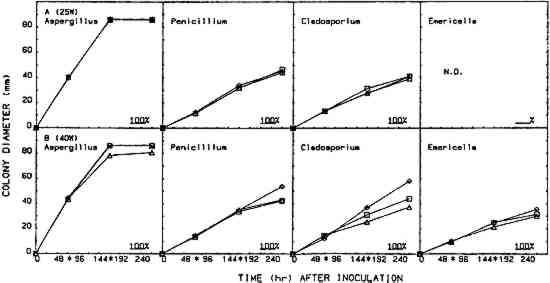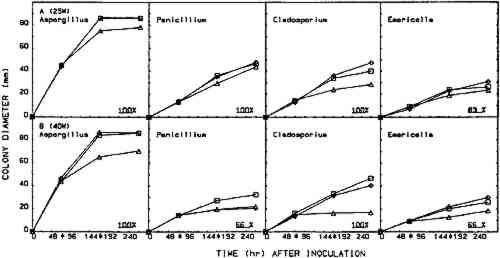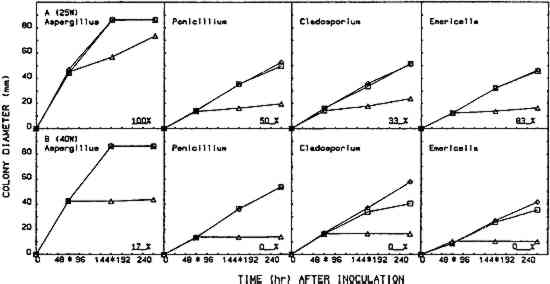FUNGICIDAL EFFICACY OF SELECTED CHEMICALS IN THYMOL CABINETSRALPH A. GUSTAFSON, INGRID R. MODARESI, GEORGIA V. HAMPTON, RONALD J. CHEPESIUK, & GLORIA A. KELLEY
3 RESULTS3.1 COLONIAL GROWTH EXPERIMENTSOF THE eight chemicals evaluated in this study using the 4-hour heating period with 25-W bulbs, only thymol (fig. 4A) and paraformaldehyde (fig. 6A) showed limited fungicidal activity. Of the remaining six chemicals, two showed some fungistasis (figs. 5A, 7A) and four were ineffective (figs. 3A, 7B–D). The activity of a specific chemical varied between the four organisms included in this study. For example, thymol had little effect on Penicillium, was somewhat fungistatic to Aspergillus and Cladosporium, and was partially fungicidal to Emericella (fig. 4A).
The use of 40-W bulbs and a 4-hour heating period increased the fungicidal activity of thymol and paraformaldehyde (figs. 4B and 6B) but did not increase the activity of paradichlorobenzene (fig. 5B) and ortho-phenylphenol (fig. 5B). Again differences in sensitivity can be observed between the four organisms. None of the chemicals evaluated effected a 100% kill against all the organisms used in these experiments. 3.2 SPORE GERMINATION EXPERIMENTSThe results of these experiments (treatment cabinet only) are shown in tables 2 and 3. The results from the control cabinet and the control incubator were all 100% germination and l00% viability (data not shown). Only paraformaldehyde prevented spore germination in the experiments using the 25-W bulbs. Paraformaldehyde and, to a limited extent, thymol inhibited spore germination when 40-W bulbs were used. Once again, differences in sensitivity are apparent. TABLE 2 Percentage of Spore Gemination During Treatment Cycle (25-W Bulb, 4-Hour Heating Period)a TABLE 3 Percentage of Spore Germination during Treatment Cycle (40-W Bulbs, 4-Hour Hearing Period)a 3.3 BOOK SAMPLING EXPERIMENTSThe results of these experiments are shown in tables 4 and 5. None of the chemicals evaluated exhibited any appreciable effect on the indigenous molds on the books in those experiments utilizing 25-W bulbs. When 40-W bulbs were used, paraformaldehyde was partially effective in reducing the viable molds but did not effect a 100% kill on all books. TABLE 4 Percentage of Books Showing Growtha (25-W Bulbs, 4-Hour Heating Period) TABLE 5 Percentage of Books Showing Growtha (40-W Bulbs, 4-hour Heating Period) |




